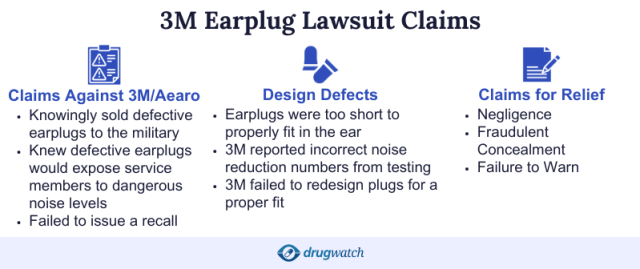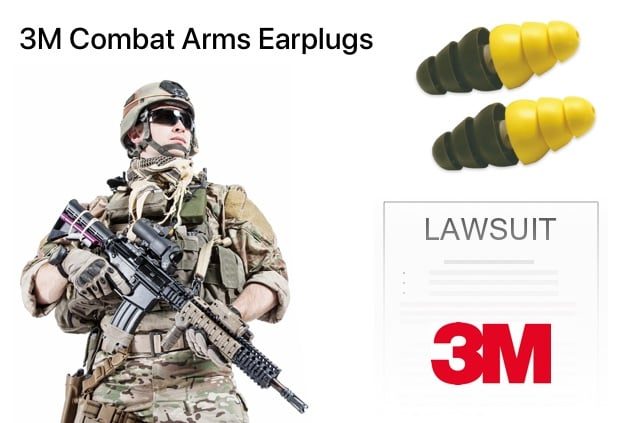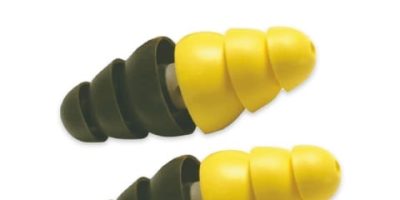3M Combat Arms Earplug Lawsuits
Military personnel who served between 2003 and 2015, used 3M Combat Arms earplugs and suffered hearing loss and tinnitus sued the manufacturer. In August 2023, 3M agreed to settle nearly 260,000 earplug lawsuits for $6 billion.
Our content is developed and backed by respected legal, medical and scientific experts. More than 30 contributors, including product liability attorneys and board-certified physicians, have reviewed our website to ensure it’s medically sound and legally accurate.
legal help when you need it most.
Drugwatch has provided people injured by harmful drugs and devices with reliable answers and experienced legal help since 2009. Brought to you by Wilson & Peterson LLP, we've pursued justice for more than 20,000 families and secured $324 million in settlements and verdicts against negligent manufacturers.
More than 30 contributors, including mass tort attorneys and board-certified doctors, have reviewed our website and added their unique perspectives to ensure you get the most updated and highest quality information.
Drugwatch.com is AACI-certified as a trusted medical content website and is produced by lawyers, a patient advocate and award-winning journalists whose affiliations include the American Bar Association and the American Medical Writers Association.
About Drugwatch.com
- 15+ Years of Advocacy
- $324 Million Recovered for Clients
- 20,000 Families Helped
- A+ BBB Rating
- 4.9 Stars from Google Reviews
Testimonials
I found Drugwatch to be very helpful with finding the right lawyers. We had the opportunity to share our story as well, so that more people can be aware of NEC. We are forever grateful for them.
- Legally reviewed by Ann Brown, Esquire
- Last update: November 3, 2025
- Est. Read Time: 6 min read
- Defendants
- Aearo Technologies Inc. and 3M Company
- Injuries in Lawsuits
- Hearing loss, tinnitus from defective plugs
- MDL
- MDL No. 2243 in the Trenton Division of the District Court of New Jersey for femur fractures and MDL No. 1789 for ONJ in the Southern District of New York
- Settlements
- $6 billion in August 2023
3M Earplug Lawsuit Status
As of January 2026, there were 0 3M Combat Arms earplug lawsuits pending out of the 391,221 that had been filed in the Northern District of Florida as part of multidistrict litigation, or MDL, 2885.
Our legal partners, and most lawyers, are no longer accepting new cases involving 3M Combat Arms earplugs.
-
July 2024
Nearly a year after 3M offered to settle these cases, 237,907 were still pending in the Northern District of Florida. According to the Official Combat Arms Earplugs Settlement Program website, $819,663,710 had been paid to 47,923 claimants.
-
March 2024
3M announced that more than 99% of the claimants opted into the settlement. According to 3M’s payment schedule, the total payments should total about $1.4 billion in 2024 and slowly increase each year until 2029 to reach the full $6 billion.
-
August 2023
On Aug. 29, 2023, 3M agreed to pay $6 billion to settle lawsuits filed by U.S. military veterans and service members who say they suffered hearing loss after using defective earplugs produced by the company.
-
June 2023
A federal judge denied 3M's Chapter 11 bankruptcy filing in military earplug lawsuits.
-
May 2023
According to the minutes of the second day of mediation proceedings, the parties did not reach a settlement but “progress was made, and negotiations continue.” MDL Judge Rodgers reported that bellwether trials in Minnesota were scheduled for July 10, 2023, Sept. 11, 2023, Oct. 23, 2023, and Feb. 5, 2024. Rodgers appointed retired judges David R. Herndon and Jeffrey J. Keyes to serve as mediators, together with Special Master Randi Ellis, to resolve the claims in the MDL.
-
January 2023
According to Bloomberg, 3M had spent more than $450 million trying to defend itself in earplug litigation.
-
August 2022
3M attempted to halt the trial proceedings through bankruptcy court, but the judge refused to pause litigation.
-
December 2022
The MDL judge placed sanctions on 3M, preventing the company from avoiding litigation in earplug claims.
-
October 2021
A jury awarded $8.2 million to a veteran who claimed he suffered hearing loss and tinnitus.
-
April 2021
A jury awarded three veterans $7.1 million in the first bellwether, or test, trial.
The U.S. Judicial Panel on Multidistrict Litigation originally consolidated 3M earplug cases from all over the country into MDL No. 2885 in the Northern District of Florida in 2019.
3M Earplug Lawsuit Settlement Amounts
According to the Official Combat Arms Earplugs (CAE) Settlement Program website, 3M has paid out about $819.7 million to 47,923 claimants as of July 2024.
In August 2023, 3M agreed to a $6 billion earplug lawsuit settlement to resolve nearly 260,000 pending lawsuits. The payments, which consist of $5 billion in cash and $1 billion in 3M stock, are expected to run into 2029.
Leading up to settlement talks in May 2023, some lawyers estimated that individual 3M earplug lawsuit settlement amounts could be anywhere from $5,000 to $250,000, depending on the damages claimed.
Prior to settling the lawsuits, 3M lost 10 of its 16 bellwether trials, in which juries awarded more than $250 million to plaintiffs.

Veterans who received VA disability compensation for hearing loss or tinnitus can continue receiving their benefits even if they pursued a claim against 3M, according to attorneys.
Because the government awards disability compensation based on disability ratings and not income level, a personal injury settlement should not impact benefits.
Why Did Veterans File 3M Earplug Lawsuits?
The main claim in 3M earplug lawsuits was that 3M Combat Arms earplugs were defective and caused hearing loss and tinnitus.
According to lawsuits, the stems of the earplugs were too short for soldiers to insert the plug deep enough into the ear canal to obtain a proper fit. This caused the plug to loosen, unbeknownst to the wearer or onlookers. When earplugs loosened, they did not provide proper protection.
Aearo Technologies, the earplugs’ original manufacturer, knew of this defect as early as 2000 before it obtained a contract to sell the earplugs to the military, according to a whistle blower lawsuit filed by Moldex.
“It is an absolute disgrace that 3M would purposefully provide defective equipment to U.S. service members, knowing that those service members would rely on that defective equipment in combat.”
During testing, Aearo personnel rolled back flanges on the noninserted side (yellow or olive) to prevent the earplugs from loosening. When 3M bought the company and took over Aearo’s military contract, the scientist and lab technician who’d tested the Combat Arms earplugs joined 3M.
The company did not inform the military of the defect or take steps to correct it, nor did it include instructions to fold back the flanges, according to a lawsuit filed by Anthony F. Ascanio.
“It is an absolute disgrace that 3M would purposefully provide defective equipment to U.S. service members, knowing that those service members would rely on that defective equipment in combat,” attorney Andrew Cobos told the Military Times. “Their fraud resulted in lifelong injuries to America’s warriors. 3M’s actions cannot, and should not, be tolerated.”
The Moldex Whistleblower Lawsuit
In 2016, Moldex-Metric Inc., which makes respiratory and hearing protection products, filed a lawsuit against 3M and Aearo Technologies. The suit claimed the company knowingly sold defective earplugs to the military, committing fraud against the government.
The lawsuit asserted that the “protracted fraud perpetrated on the military by 3M, whose dual-ended Combat Arms earplugs — which were standard issue in certain branches of the military during foreign conflicts between 2003 and 2015 — have likely caused thousands of soldiers to suffer significant hearing loss and tinnitus in addition to exposing millions to the risk caused by 3M’s defective earplugs.”
3M admitted no wrongdoing but agreed to pay $9.1 million to settle the allegations in July 2018, according to a DOJ press release.

Aearo Technologies originally designed and obtained an exclusive military contract for the dual-ended Combat Arms earplugs in 2003. In 2008, 3M bought the company and took over the contract.
When they sold the earplugs to the military, 3M and Aearo claimed the unique dual-ended design allowed soldiers to insert the olive side to protect against all sound. With the yellow side inserted, the earplugs protected against explosions but allowed soldiers to hear spoken commands or approaching enemies.
3M’s Misleading Earplug Test Results
Not only did Aearo and 3M manufacture a defective product, but they also misrepresented its effectiveness to the military and the soldiers using it, lawsuits claim.
To sell its earplugs to the military, Aearo had to meet a certain Noise Reduction Rating requirement. But lawsuits say Aearo and 3M misrepresented the results of the NRR tests to the military.
“3M (ATI at the time) did not commission an independent lab to conduct the testing on the Combat Arms Earplugs as federal law and the military solicitations required,” according to Anthony F. Ascanio’s lawsuit. “Rather, 3M purported to conduct the testing in-house, and it was a sham.”
“3M (ATI at the time) did not commission an independent lab to conduct the testing on the Combat Arms Earplugs as federal law and the military solicitations required. Rather, 3M purported to conduct the testing in-house, and it was a sham.”
The NRR required for the olive-colored end was 25 to 40 decibels, and it was 0 to 25 decibels for the yellow end, according to Ascanio’s lawsuit.
During initial testing, Aearo found the olive-colored end only reached an NRR of 10.9 on average. The results were disappointing, and they stopped testing on the olive end.
The yellow end reached -2 NRR. At -2, the yellow end of the earplug actually amplified the sound and functioned as a hearing aid would, according to the whistleblower lawsuit.
Aearo retested the olive end after folding back the yellow flange. By doing this, they were able to achieve a 22 NRR. For the yellow end, Aearo reported the -2 NRR as a 0. The company reported these results to the military and placed them on marketing materials.
Examples of Hearing Loss and Tinnitus Lawsuits
Soldiers who thought the Combat Arms earplugs protected them were actually at risk of hearing damage. Injuries claimed in lawsuits include hearing loss, tinnitus and loss of balance, according to the Military Times.
Scott D. Rowe
Texan Scott D. Rowe was one of the first veterans to file a lawsuit against 3M. An Army combat veteran, Rowe, was stationed primarily in Fort Hood and Fort Lewis, his lawsuit said. From 2003 to 2004, Rowe was deployed to Iraq as part of Operation Iraqi Freedom. He served in the 4th Platoon of the 411th Military Police Company, known as the “Fighting Bastards.”
Earplug Use:
The Army issued Rowe 3M dual-ended Combat Arms earplugs while he was at Fort Hood, Fort Lewis, and Iraq. He used them during combat and training.
Injuries Claimed:
Rowe suffers from hearing loss and tinnitus. “Every day I have to live with a high-pitched frequency in my ear that’s deafening. I’m never at peace,” Rowe told Courthouse News Service.
Anthony F. Ascanio
Anthony F. Ascanio joined the Marines in 2009, when he was 21. He was stationed at bases in California and Hawaii. He also served two deployments to Afghanistan during Operation Enduring Freedom.
Earplug Use:
During Ascanio’s service, 3M’s dual-sided Combat Arms earplugs were standard issue. He used them during training exercises and on the battlefield in Afghanistan. He used the earplugs as instructed and was never told to fold back the flanges of the earplug, according to his lawsuit.
Injuries Claimed:
Ascanio suffers from bilateral hearing loss and tinnitus.
Hearing loss is an important concern for the U.S. Department of Defense because it impacts operational effectiveness, medical readiness and quality of life, according to J.T. Nelson and colleagues’ article in Hearing Research.
- A feeling of “fullness” in the ears after leaving a noisy area, such as a concert venue
- Buzzing or ringing in the ears
- Difficulty hearing someone talking three feet away
- Difficulty understanding what people are saying
Each branch of the military performs routine hearing tests on service members and keeps a record of the results.
Calling this number connects you with a Drugwatch.com representative. We will direct you to one of our trusted legal partners for a free case review.
Drugwatch.com's trusted legal partners support the organization's mission to keep people safe from dangerous drugs and medical devices. For more information, visit our partners page.




